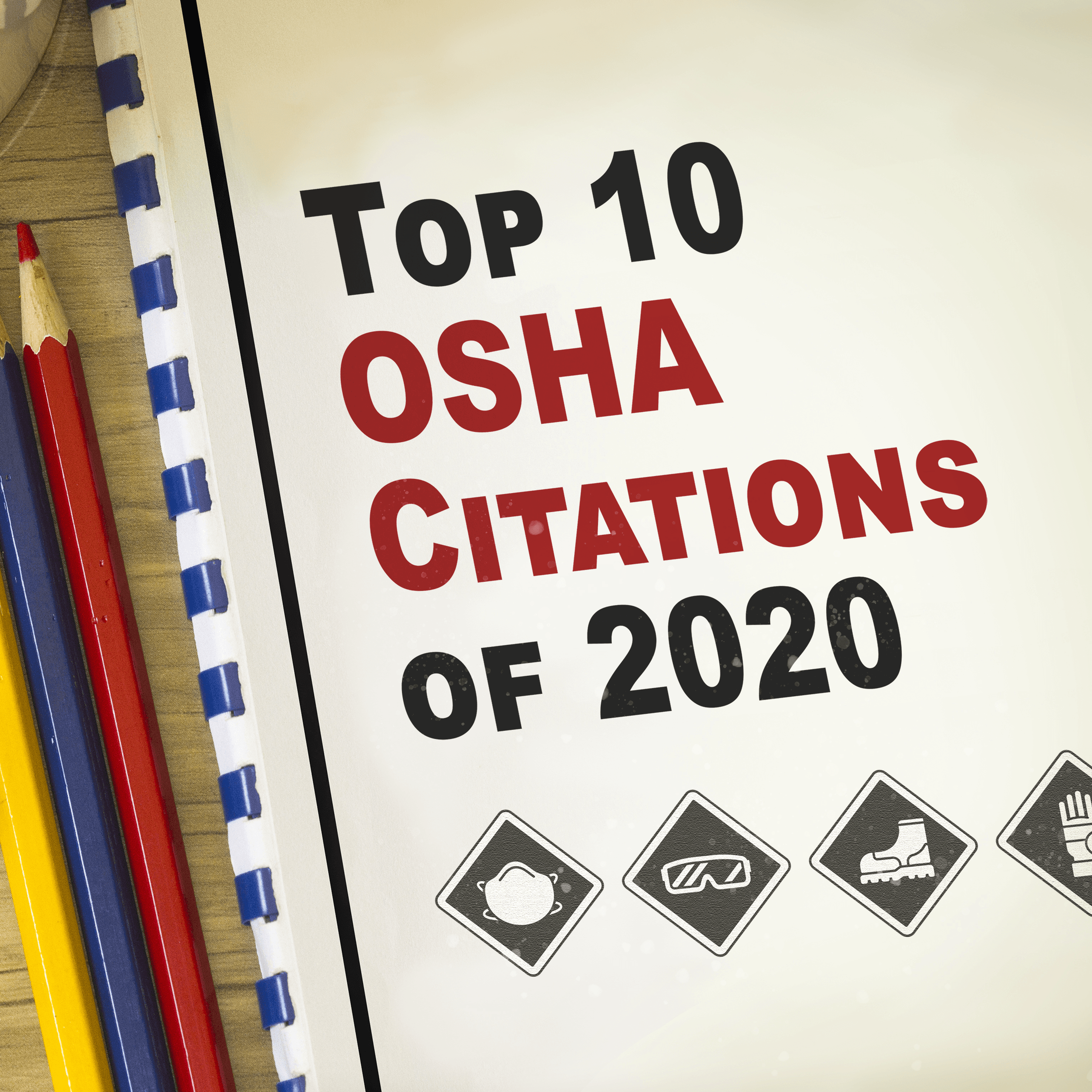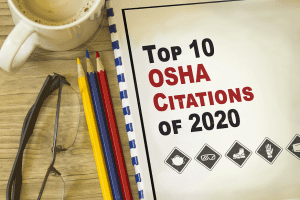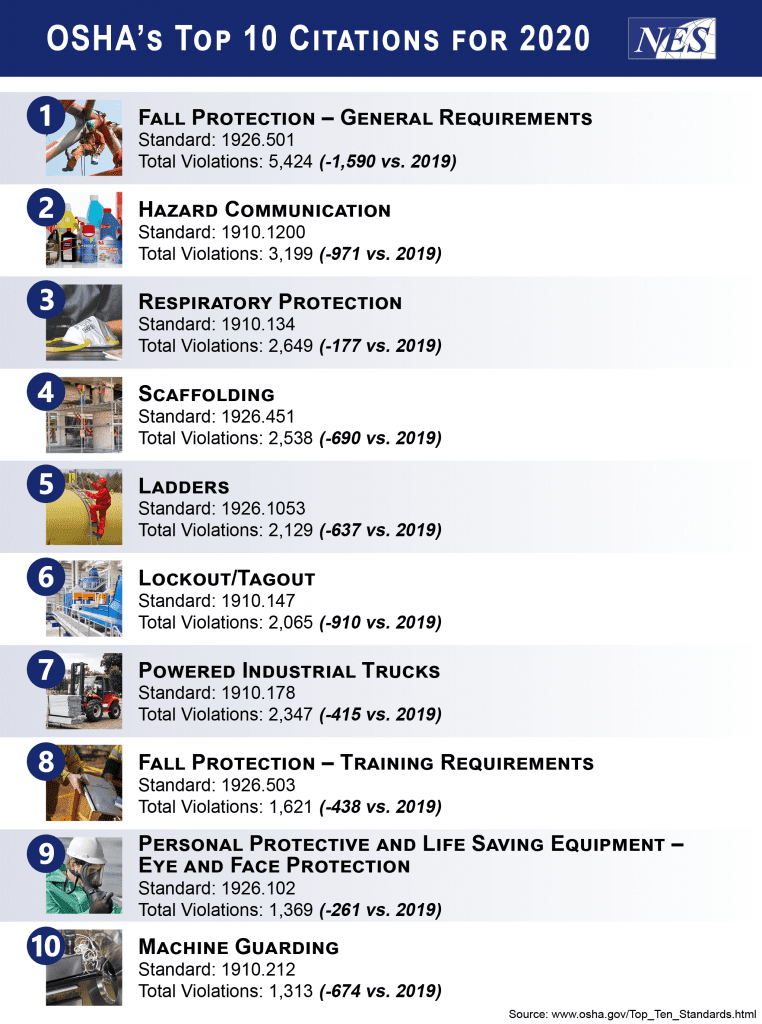
OSHA’s Top 10 List of Citations for 2020

Written by: Virginia McCormick, NES, Inc.

After months of pandemic-related delay, the finalized 2020 OSHA Top 10 list of citations has been released.
Numbers for the 2020 OSHA Top 10 List Confirmed
Federal OSHA’s Top 10 list of frequently cited violations for fiscal year 2020 was recently confirmed. While several standards have swapped positions, the 2020 list did not see any new entries compared to 2019. However, 2020 marks the tenth successive fiscal year that Fall Protection topped the list.
Preliminary numbers were announced earlier this year by OSHA deputy director Patrick Kapust during a February Safety+Health Magazine webinar, but the finalized list with official numbers was delayed. The final list was only recently released on OSHA’s website. The delay was ultimately due to the COVID-19 pandemic slowing down the agency’s process – a struggle familiar to most business owners operating in the past year.
Check out the following NES graphic for a complete listing of the 2020 OSHA Top 10 categories of violations, including the associated standards, the number of citations given, and the respective decreases as compared to 2019.

The above list portrays the OSHA regulations and statistics for 2020. The fiscal year ran from October 1, 2019 to September 30, 2020.
OSHA publishes the Top 10 list annually to, “alert employers about these commonly cited standards so they can take steps to find and fix recognized hazards addressed in these and other standards.” However, the list should never be the only resource for an employer to consider when striving to ensure a safe and healthful workplace. Instead, Kapust recommends employers use the 2020 OSHA Top 10 list as a guide: “It’s a good place to start if you don’t know where to start. Look at what OSHA is finding. Look at the things that are applicable to your particular industry as well.”
Missed last year’s Top 10 list? For more information, see the NES article OSHA’s Top 10 List of Citations for 2019.
Fall Protection Heads OSHA Top 10 List for 10 Years Straight
For the past 10 years, Fall Protection (29 CFR 1926.501) has topped the annual OSHA Top 10 list. Though the total number of fall protection violations in 2020 decreased in comparison to last year’s count, falls are still considered one of the most common causes of serious work-related injuries and deaths. As such, employers must take measures to prevent employees from falling off overhead platforms or elevated workstations or into holes in the floor and walls. Falls are considered a ubiquitous risk at many worksites. However, OSHA has published several industry-specific resources relating to fall protection, from construction, to roofing operations, to commercial fishing.
Employers are required to provide a complete and relevant training program for each employee who might be exposed to fall hazards in the workplace. According to the standard, the program must enable each employee to recognize the hazards of falling and must train each employee on how to minimize these hazards. Fall protection training includes training on the nature of fall hazards, the correct use of fall protection systems, and the role employees play in fall protection plans.
Along with Fall Protection, Hazard Communication (29 CFR 1910.1200) also maintained its spot from the previous year’s list. Hazard Communication provides employees with important knowledge regarding the chemicals they are exposed to and the steps they must take in order to protect themselves. The standard also provides employers the information they need to design an effective hazard communication program. Hazard Communication stayed at the second spot for the 2020 list.

Fall Protection once again leads the OSHA Top 10 list of citations.
Position Swapping & Violation Decreases Following Pandemic Year
In comparison to the first and second spots, the 2020 OSHA Top 10 list’s third, fourth, and fifth spots all changed as compared to the 2019 list.
Respiratory Protection (29 CFR 1910.134) sets expectations for control measures, respirator use, cleaning and repair, written programs, and worker medical evaluations. Citations related to this standard are typically issued for medical evaluation requirements, implementation of a written Respiratory Protection Program, and fit testing. And with the pandemic highlighting concern over the respiratory transmission of infectious diseases, it is obvious why Respiratory Protection, which was fifth in 2019, now occupies the third spot.
Scaffolding (29 CFR 1926.451) – which is further addressed in specific OSHA standards for general industry, maritime, and construction – dropped from the third to the fourth spot in 2020.
Ladders (29 CFR 1926.1053) climbed from sixth to fifth as compared to last year’s list. Both standards are closely related to the Fall Protection standard that tops the list. The importance of protecting employees from falls cannot be overstated, and OSHA has published dozens of free resources relating to the standard for employer and employee use.

Potentially as a result of the COVID-19 pandemic, respiratory protection violations jumped from fifth to third in the 2020 OSHA Top 10 list.
In addition to many violation categories swapping places, every standard on the 2020 list saw a decrease in the number of citations given out as compared to 2019. While this is overall a positive outcome, it is important to remember that the 2020 list was developed in the height of the COVID-19 pandemic. Kapust stated in his February Q&A with Safety+Health Magazine that the agency shifted much of its operations to address pandemic-related complaints and fatalities early on.
The decreases in the 2020 list may be more accurately attributed to OSHA having to cut back on the usual targeted inspections, rather than the actual number of citable violations being reduced. Regardless, Kapust stated that the agency is planning to conduct a, “deep dive on what impact [its] enforcement had during the pandemic and implementing some lessons learned for future emergency responses.”
The remainder of the 2020 OSHA Top 10 List also saw decreases in the number of violations. Spots six through ten of this year’s list – and their associated regulatory citations – were as follows:
- Lockout/Tagout (29 CFR 1910.147)
- Powered Industrial Trucks (29 CFR 1910.178)
- Fall Protection – Training Requirements (29 CFR 1926.503)
- Eye and Face Protection (29 CFR 1926.102)
- Machinery and Machine Guarding (29 CFR 1910.212)

Remember, OSHA is not trying to reach goals for violations or penalties given. Rather, the agency performs inspections to ensure standards are being enforced and workplaces are staying safe.
How to Prepare for an Inspection
No employers want their workplace to be unsafe. But sometimes, despite the best of intentions, employers can find themselves on the receiving end of an OSHA violation. The best way to prepare for an OSHA inspection is to seriously dedicate yourself to developing, training, and upholding good workplace practices. However, there are some broad steps that employers and their workers can take in order to prepare for OSHA inspections.
- Identify the roles needed for a smooth inspection. Roles may include employee(s) who may greet an inspector upon arrival as well as a company liaison(s) who will check inspector identification cards and notify management. Each role will have specific assigned duties for when an inspection takes place. By identifying these roles well before an inspection takes place, specific duties will become easier to implement and inspections will run smoother.
- Know what to expect during an inspection. The Certified Safety and Health Official (CSHO) will often disclose the reason(s) for conducting an inspection during an opening conference. Following the conference is the inspection walk-through, in which the accompanied CSHO tours the facility and documents any observations or citations. The inspector may conduct one-on-one interviews with specific employees. After the walk-through and interviews is a closing conference, which is the opportunity to clarify anything taken into consideration by the inspector. This is the typical structure for an inspection. Knowing the structure for an inspection before one takes place will cause less confusion and fewer problems in general.
- Participate in regular hazard training or consulting. Regular training will boost employers’ and their workers’ understanding of what possible violations look like and how to deal with them before an inspection takes place.

When employees are treated with the respect for safety and health that is built into the regulations, everyone benefits.
Violations are often the products of willful negligence. In order to avoid costly violations, employers must always be proactive, rather than reactive, when it comes to establishing and maintaining workplace safety. While the 2020 OSHA Top 10 list is a good place for employers to start when considering workplace hazards, it is highly advised that employers resolve citable issues before a citation – or worse, an injury or fatality – occurs at their business.
With greater emphasis by employers on establishing and maintaining company safety and health programs and providing regular, job-specific training to employees, citation numbers may continue to decrease in 2021.
NES: Helping Employers Stay Off OSHA’s Top 10 List for 2021
“It’s been a challenging time for all of us,” noted Kapust in his Q&A with Safety+Health Magazine. “Some folks have been working tirelessly on the front lines to keep the country going. Others have seen their workplaces closed and are maybe just now returning to work. OSHA is here to help make sure that workers can continue to be on the job safely and that employers have the information they need to make that happen.”
When it comes to staying off OSHA’s Top 10 list and out of trouble, the bottom line for employers is to be informed of all required safety measures and to dispense the information to employees through regular training conducted by qualified training providers. Ultimately, there is no substitute for training and consulting that can keep employers and employees safe and off the OSHA violations list. NES can help achieve this goal.
If your business or agency requires assistance with its training or consulting needs to help educate employees, prepare for inspections, and remain in compliance with applicable rules and regulations, NES can provide experienced environmental, health & safety professionals to get your operations on the right track (view our open enrollment training page by clicking here). For more information about our environmental, health & safety training and consulting capabilities, contact NES at 916-353-2360 / 1-800-NES-ADVISE (1-800-637-2384) or office@nesglobal.net.
References:
Safety+Health Magazine: 10th year running: Fall Protection leads OSHA’s annual ‘Top 10’ list of most frequently cited violations
Safety+Health Magazine: OSHA’s Top 10 most cited violations for FY 2020
Fall Protection 29 CFR 1926.501 [related OSHA Safety and Health Topics page]
Hazard Communication 29 CFR 1910.1200 [related OSHA Safety and Health Topics page]
Respiratory Protection 29 CFR 1910.134 [related OSHA Safety and Health Topics page]
Scaffolding 29 CFR 1926.451 [related OSHA Safety and Health Topics page]
Ladders 29 CFR 1926.1053 [related OSHA Safety and Health Topics page]
Lockout/Tagout 29 CFR 1910.147 [related OSHA Safety and Health Topics page]
Powered Industrial Trucks 29 CFR 1910.178 [related OSHA Safety and Health Topics page]
Fall Protection – Training 29 CFR 1926.503 [related OSHA Safety and Health Topics page]
Eye and Face Protection 29 CFR 1926.102 [related OSHA Safety and Health Topics page]
Machinery, Machine Guarding 29 CFR 1910.212 [related OSHA Safety and Health Topics page]
